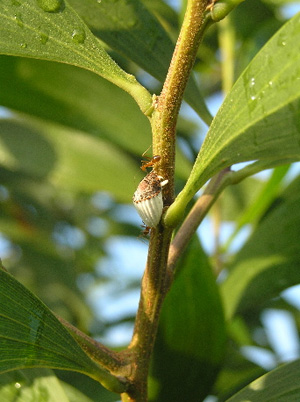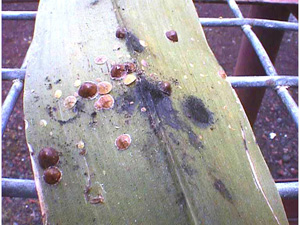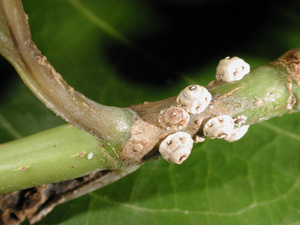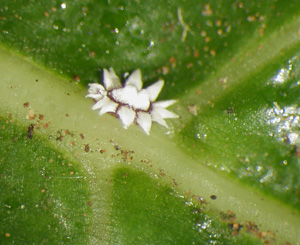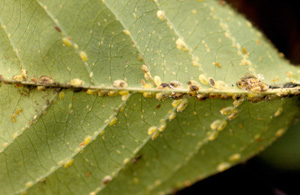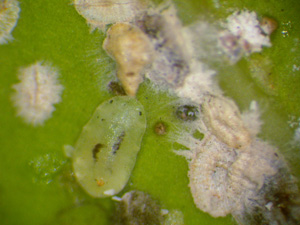Scales, Soft
Click on images to enlarge.
Cottony Cushion Scale on Koa
Photo: Dr. Scot C. Nelson, CTAHR
Hemispherical Scale
Photo: Brian Bushe, CTAHR
Barnacle Scale
Photo: Dr. Arnold Hara, CTAHR
Immature Barnacle Scale
Photo: Brian Bushe, CTAHR
Green Scale on Gardenia; photo shows both parasitized (brown) and live (yellow-green) scale
Photo: Dr. Arnold Hara, CTAHR
Green Scale with Verticillium lecanii infected neighbors. V. lecanii, or “white halo” fungus, is a common pathogen of scale insects in the tropics and sub-tropics.
Photo: Brian Bushe, CTAHR
Problem
The leaves of affected plants wilt, turn yellow, and fall off. There may be spots on leaves and twigs as well as the presence of honeydew and sooty mold. You may see ants, which are attracted to the honeydew. Scale insects can infest the bark, fruit, twigs or leaves of shrubs and trees.
Description
Scales attack a wide variety of trees, shrubs and other perennials. Some scales do not cause much damage to plants, whereas others can cause devastating loss. It is important to accurately identify the species of scale because control is different for soft scales and armored scales. Using the wrong control method is not only a waste of time and money, it can actually make the problem much worse.
Soft scales (Coccidae) vary in appearance, as you see by the photos. They can be smooth, cottony, or waxy and are about 1⁄4 inch in length. Generally, they are bigger and more rounded in shape than armored scales. The adult females do not have wings, nor can you see a head or legs; males are gnat like with tiny wings and are seldom seen because they live only a few hours and do not feed.
Soft scales have no true armor; rather, the body of the insect is hardened by wax-like secretions. The protective cover is an integral part of the body and cannot be removed. Soft scales have short piercing mouthparts and females are not permanently fastened to the plant while feeding. Soft scales excrete honeydew which leads to the growth of sooty mold. Armored scale insects do not excrete honeydew.
Information
- Scales (University of California, IPM On-line)
Scale Look-Alikes
It can be confusing trying to correctly identify scale insects. There are other pests that look a lot like scale, for example coconut mealybug, parasitized whitefly nymphs, and redgum lerp psyllid (HDOA Pest Advisory: Red Gum lerp psyllid).
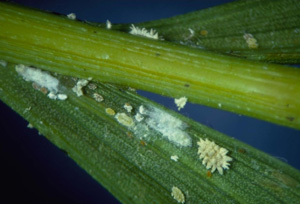
Coconut Mealybug
Photo: Brian Bushe, CTAHR
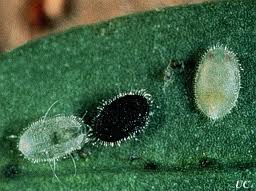
Parasitized whitefly nymphs
Photo: University of Florida, Entomology Department
Control
Soft scales are known to reduce plant vigor, but they seldom kill trees or shrubs. These insects are generally well controlled by natural predators such as, parasitic wasps, lady beetles, and lacewings. Do not use broad spectrum pesticides as these will kill the natural predators. With soft scales, ants will be attracted to excess honeydew produced by the scales, and they will, in turn, keep natural predators away. If you control the ants, the natural enemies will move in and control the scale insects. This is not an instant fix and you must be patient and give the predators time to do their work. It may take months. You can encourage natural enemies of scale by planting blooming plants nearby and by trying to keep the dust off of affected plants.
If the infestation is too large, you can try using a horticultural (narrow-range) oil spray, making sure that you spray the undersides of the leaves as well as the top side and all infested branches. You could also try using insecticidal soap or a soap and oil spray on the affected areas. Complete coverage of infested plants (such as the undersides of leaves) is needed to obtain good control. You can also prune heavily infested branches if the entire plant is not affected.
Provide optimal growing conditions for your plants so that they are vigorous and can fight off infestation. It also makes sense to select trees and shrubs that are well adapted to the environment. If you have plants in your yard that repeatedly are attacked by scale or other pests, consider removing them and planting something better adapted.
Chemical Control - See an extension agent or the UC Davis website above for more information on chemical control, control of ants, and use of horticultural oils. It is important to correctly identify the scale that is infesting your plants. One insecticide, for example, controls most soft scales but does not control armored scales or cottony cushion scale. This insecticide can actually increase cottony cushion scale populations on your plants because it is very toxic to the vedalia lady bird beetle, Rodolia cardinalis. This natural predator is poisoned by feeding on scales that have ingested the insecticide. When the natural predators in your yard die, the number of pests can skyrocket.
Kendal Lyon, Hawaii Island Master Gardeners


